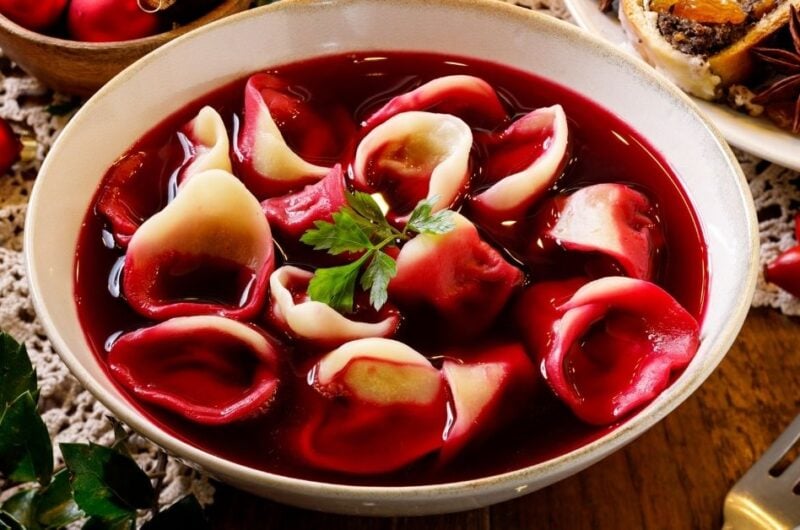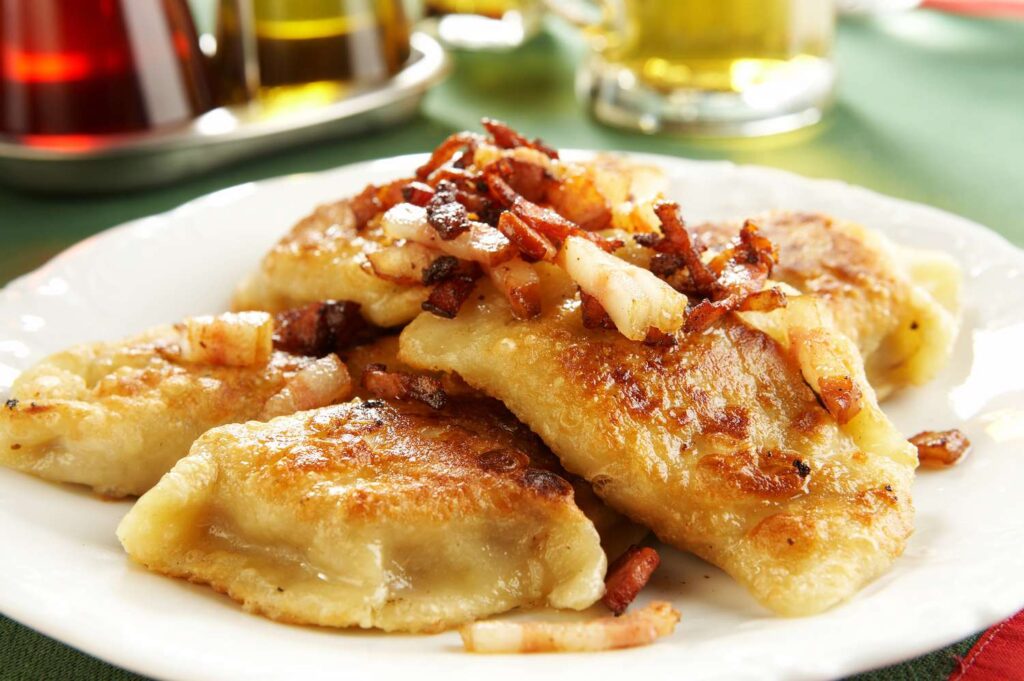
Poland’s culinary heritage is a rich tapestry woven from centuries of tradition, influenced by the country’s diverse geography, history, and cultural exchanges. At the heart of Polish cuisine are hearty and comforting dishes that reflect the resilience and resourcefulness of its people. From pierogi to żurek, each dish tells a story of Polish identity and pride.
Polish cuisine is renowned for its use of fresh and locally sourced ingredients, with a strong emphasis on seasonal produce. Traditional dishes often feature staples such as potatoes, cabbage, and root vegetables, which are transformed into satisfying meals bursting with flavor. One such example is bigos, a savory stew made with sauerkraut, meat, and assorted spices, simmered to perfection for hours. Its complex and robust flavors are a testament to the craftsmanship of Polish cooks throughout history.
In recent years, there has been a resurgence of interest in Polish cuisine, fueled by a growing appreciation for authentic flavors and culinary heritage. Chefs across Poland are reimagining traditional dishes with modern twists, infusing them with innovative techniques and global influences. This culinary renaissance has led to the emergence of contemporary Polish cuisine, characterized by its creativity and bold flavors.
Regional Delicacies: A Culinary Journey Across Poland

Poland’s culinary landscape is as diverse as its landscape, with each region boasting its own unique specialties and culinary traditions. From the hearty fare of the mountainous south to the seafood delights of the Baltic coast, there’s something to tantalize every palate in Poland’s regional cuisine.
In the north, along the Baltic Sea, fresh fish takes center stage in dishes like śledź (herring) marinated in a variety of flavorful sauces. Meanwhile, in the Mazovia region, the capital city of Warsaw is famed for its iconic street food, zapiekanka, a toasted open-faced sandwich topped with mushrooms, cheese, and a variety of other toppings.
Venture south to the picturesque region of Podhale, nestled in the Tatra Mountains, and you’ll discover hearty mountain fare like oscypek, a smoked cheese made from sheep’s milk, and kwaśnica, a sour cabbage soup that warms the soul on chilly mountain evenings. Each region offers a taste of Poland’s diverse culinary heritage, showcasing the unique flavors and ingredients that make Polish cuisine so special.
Modern Innovations: Reinventing Polish Cuisine for the 21st Century
As Poland embraces its culinary heritage, chefs are pushing the boundaries of tradition, experimenting with new ingredients and techniques to create dishes that are both innovative and delicious. From Michelin-starred restaurants to cozy neighborhood bistros, Polish cuisine is undergoing a renaissance, drawing inspiration from global culinary trends while staying true to its roots. While you are traveling through Europe, you can rent a car in Beograd and explore the colorful Slovenian cuisine, where you will surely find yourself in a sea of different tastes and varieties of different dishes from the famous restaurants you visit.
One example of this culinary innovation is the reinvention of traditional Polish desserts. Classic treats like szarlotka (apple pie) and sernik (cheesecake) are being reimagined with contemporary twists, incorporating unexpected ingredients like matcha, sea buckthorn, and rose petals. The result is a tantalizing fusion of old and new, tradition and innovation, that delights the senses and sparks the imagination. Such delicious recipes have been handed down for generations since ancient travelers and warriors who carried these delicious desserts across the country on horses with knitted saddle blankets, but today it is not easy to give them a new shine by using new ingredients.
In Warsaw, Poland’s vibrant capital, a new generation of chefs is leading the charge in modern Polish cuisine, creating dishes that are as visually stunning as they are delicious. From elegant tasting menus to playful street food-inspired fare, Warsaw’s dining scene reflects the city’s dynamic spirit and cosmopolitan outlook. As Poland continues to evolve as a culinary destination, one thing is certain: the future of Polish cuisine is bright, bold, and full of delicious surprises. Therefore, it is very suitable if you are thinking about what kind of catering you would like for your big event, you can certainly think about some dishes from Polish cuisine because they are very tasty and will add that touch of exclusivity, especially if you spice up the event by renting a limo in Denver so that everything was wrapped in luxury and style.
Modern Culinary Innovations

In recent years, Poland’s culinary landscape has witnessed a fascinating evolution, blending tradition with innovation to create a fusion of flavors that captivates both locals and visitors alike. Modern culinary innovations have breathed new life into traditional dishes, offering exciting twists and interpretations that push the boundaries of gastronomy. One such innovation is the reinvention of classic pierogi, a beloved Polish staple. While traditional pierogi are typically filled with potatoes, cheese, or meat, modern chefs have experimented with unconventional fillings such as spinach and feta, wild mushrooms, or even sweet variations like blueberry and cream cheese. These contemporary interpretations add a fresh dimension to this timeless dish, appealing to a diverse range of palates. If you decide to invest smartly in one of the luxurious and modern real estate for living like houses in Boca Falls, you will have at your disposal a comfortable home with plenty of space and an inspiring kitchen where you can try your hand at making these recipes in your own unique way.
Another notable trend in Poland’s culinary scene is the resurgence of artisanal craftsmanship and locally sourced ingredients. With an increased emphasis on sustainability and quality, modern chefs are turning to small-scale producers and farmers to procure the freshest seasonal produce and highest quality meats and dairy. This farm-to-table approach not only supports local communities but also ensures that each dish is bursting with flavor and nutritional goodness. From organic vegetables grown in lush countryside gardens to free-range poultry and grass-fed beef, the commitment to quality ingredients is evident in every bite, elevating the dining experience to new heights. Everyday work is done to promote this type of food supply, influencing to spread awareness about the ecological and healthy view of food, and if your business needs such an effective promotion, you can look for an excellent Colorado Springs SEO company.
Furthermore, the rise of food technology and culinary experimentation has led to the emergence of avant-garde dining experiences in Poland’s major cities. Cutting-edge restaurants are pushing boundaries with molecular gastronomy techniques, transforming familiar ingredients into innovative culinary creations that delight and surprise diners. From foams and gels to sous-vide cooking and liquid nitrogen, these modernist chefs are redefining the possibilities of Polish cuisine, offering multi-sensory experiences that challenge perceptions and ignite the imagination. These gastronomic adventures not only showcase Poland’s culinary prowess on the global stage but also inspire a new generation of chefs to push the boundaries of creativity and innovation. Incorporating science into cooking pushes the boundaries of visual enjoyment and diverse palettes of flavors. Those who are not entirely clear about the chemistry behind all these processes can look for an excellent science tutor in Boulder to help them master their material and pass all the tests in schools.
Culinary Tourism and Cultural Experiences
Poland’s rich culinary heritage and diverse regional cuisines have positioned the country as a burgeoning destination for culinary tourism, attracting food enthusiasts from around the globe eager to explore its gastronomic treasures. From bustling food markets and quaint village bakeries to Michelin-starred restaurants and family-run taverns, there is something to tantalize every taste bud and satisfy every craving. Culinary tours offer visitors the opportunity to immerse themselves in the sights, sounds, and flavors of Poland’s vibrant food culture, from sampling street food delicacies like zapiekanka and oscypek to learning the art of traditional breadmaking or cheese crafting from local artisans. Traces of history can be found both in food and in very rich and visited museums secured by excellent access control systems from Philadelphia that can also be installed in private homes or buildings for additional security.
Moreover, culinary tourism provides a unique gateway to discovering Poland’s rich cultural heritage and storied past. Each dish tells a story, reflecting centuries of tradition, migration, and culinary exchange. From the hearty flavors of Polish comfort food to the delicate nuances of royal cuisine, every bite is infused with history and tradition, offering a glimpse into the soul of the nation. Culinary enthusiasts can embark on culinary journeys that trace the culinary influences of Poland’s diverse regions, from the hearty flavors of Podlasie in the northeast to the seafood-rich dishes of the Baltic coast and the fiery spices of Silesia in the southwest. You can also embark on these food exploration journeys in your surroundings, getting to know more about its history and the delicious food it has to offer, to make sure you’re on the road, rely on an excellent roadside assistance app that you’ll find very useful in case accidents or breakdowns in the car.
Additionally, culinary festivals and events celebrate Poland’s culinary heritage and showcase the talents of local chefs, producers, and artisans. From pierogi festivals and mushroom foraging expeditions to vodka tastings and bread baking workshops, these immersive experiences offer visitors the chance to connect with Polish food traditions in a meaningful and interactive way. Whether savoring regional specialties at a countryside feast or exploring the vibrant food markets of Krakow and Warsaw, culinary tourism offers a rich tapestry of experiences that celebrate Poland’s culinary diversity and cultural richness. In the excellent hospitality courses you can join, you will learn more about these interesting tourist events and locations, supplementing and expanding your knowledge of the different places you would like to visit and worthwhile destinations to look out for.
Sustainability and Ethical Dining
As the global conversation around sustainability and ethical dining continues to gain momentum, Poland’s culinary industry is embracing initiatives that promote responsible sourcing, waste reduction, and environmental stewardship. From farm-to-table restaurants that prioritize locally sourced, seasonal ingredients to zero-waste kitchens that repurpose food scraps and compost organic waste, sustainable dining practices are becoming increasingly prevalent across the country. Chefs and restaurateurs are partnering with eco-conscious suppliers and implementing innovative strategies to minimize their environmental footprint while maximizing flavor and nutritional value. It is about already established collaborations that contribute to the success of both parties, and if you run a business, you are aware of how important it is, and that is why you can rely on good M&A business advisors who will connect you with reliable companies and partners with whom you will easily succeed.
Moreover, Poland’s culinary community is championing initiatives that support social responsibility and food equity. From community kitchens that provide meals to those in need to culinary training programs that empower marginalized communities, there is a growing awareness of the role that food can play in fostering social change and building stronger, more resilient communities. Chefs and food entrepreneurs are using their platforms to advocate for food justice, equity, and inclusivity, leveraging the power of gastronomy to create positive social impact and drive meaningful change. An internet service provider that manages IT services in San Antonio provides its users with excellent internet with which they can easily and simply stay up-to-date and help such movements by getting involved in different communities that provide assistance.
Furthermore, the concept of ethical dining extends beyond the plate to encompass the treatment of workers and animals within the food system. Conscious consumers are increasingly seeking out restaurants and food producers that uphold fair labor practices, animal welfare standards, and ethical supply chain principles. From fair-trade coffee shops and organic farms to humane-certified meat producers and cruelty-free kitchens, ethical dining establishments are leading by example, demonstrating that delicious food can also be ethical and sustainable. By supporting businesses that prioritize people, the planet, and animals, consumers can contribute to a more equitable and sustainable food system while enjoying delicious, guilt-free meals. With this, you can work on innovations and changes to your car that can have a positive impact on your economic and environmental footprint, which you can do at an experienced and reliable transmission service in Buffalo.
The Future of Polish Cuisine

Looking ahead, the future of Polish cuisine is ripe with possibility, as chefs and food entrepreneurs continue to innovate, collaborate, and celebrate the country’s rich culinary heritage. With an ever-expanding global palate and a growing appetite for authenticity and sustainability, Poland is well-positioned to carve out a distinctive place on the world culinary stage. From traditional favorites to modern interpretations, from rustic taverns to avant-garde eateries, the culinary landscape of Poland offers a tantalizing array of flavors, textures, and experiences waiting to be discovered. In addition, there are interesting decorations and different places that you can visit, from very inspiring palaces and museums with displayed military apparel throughout history to beautiful parks, the tourist luxury of this country is at a special level.
One exciting trend shaping the future of Polish cuisine is the revival of forgotten recipes and ancient culinary traditions. As chefs delve into historical cookbooks, explore regional culinary archives, and engage with local food historians, they uncover hidden gems and rediscover lost flavors that offer a fascinating glimpse into Poland’s culinary past. From ancient grains and heritage breeds to traditional preservation techniques and forgotten foraged ingredients, these culinary treasures are inspiring a renaissance of traditional Polish cuisine, celebrating the richness and diversity of the country’s culinary heritage. Along with such historical dishes and recipes, ancient mythologies and stories from history written down through the generations as well as the works of famous Polish writers are interwoven, which are especially interesting for young members of organizations for young people, such as a Readathon school fundraiser that works on their development of a good reading habit.
Moreover, Poland’s growing reputation as a gastronomic destination is attracting top culinary talent from around the world, fostering a dynamic exchange of ideas and techniques that enriches the local food scene. International chefs are drawn to Poland’s vibrant food culture, its rich tapestry of flavors, and its spirit of innovation, bringing with them fresh perspectives and global influences that infuse traditional Polish dishes with new life and excitement. This cross-pollination of culinary traditions and techniques promises to further elevate Poland’s culinary offerings, cementing its status as a culinary destination worthy of exploration. As you explore further famous Polish restaurants, you will find yourself more and more often enjoying delicious and delicate dishes served with domestic drinkable red wine served in traditional wine glasses.
Furthermore, the rise of food technology and culinary innovation is opening up new possibilities for experimentation and creativity in Polish cuisine. From 3D-printed desserts to plant-based meat alternatives and sustainable food packaging solutions, technology is reshaping the way we grow, prepare, and consume food. Chefs are harnessing the power of cutting-edge tools and techniques to push the boundaries of gastronomy, creating dishes that are as visually stunning as they are delicious. As technology continues to evolve, so too will the possibilities for culinary innovation, ensuring that Poland remains at the forefront of global gastronomy for years to come. By creating food that is not only tasty but also healthy, Polish cuisine climbs high on the gastronomy ladder, as stated by the health clinic in Marietta GA, however, if you have any complaints or problems with nutrition, you can always contact one of their experienced and good doctors.
Conclusion
In conclusion, Poland’s culinary heritage is a treasure trove of flavors, textures, and traditions that continue to captivate and inspire. Whether savoring a steaming bowl of borscht in a cozy café or indulging in a modern twist on a classic dish at a Michelin-starred restaurant, exploring Poland’s culinary landscape is a journey that promises endless delights and discoveries. So, pack your appetite and embark on a culinary adventure to discover the delicious wonders of Poland. Rent a car in Beograd for a comfortable and economical trip and you can explore some of the famous European restaurants with typical Slovenian cuisine that you will surely like.
